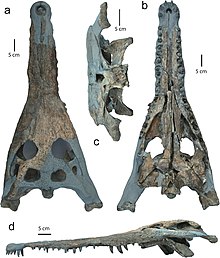Penghusuchus
| Penghusuchus | |
|---|---|

| |
| Skull | |
| Scientific classification | |
| Domain: | Eukaryota |
| Kingdom: | Animalia |
| Phylum: | Chordata |
| Class: | Reptilia |
| Clade: | Archosauromorpha |
| Clade: | Archosauriformes |
| Order: | Crocodilia |
| Family: | Gavialidae |
| Genus: | †Penghusuchus Shan et al., 2009 |
| Type species | |
| †Penghusuchus pani Shan et al., 2009
| |
Penghusuchus is an
Discovery
On 25 March 2006, on the coast of Neian, Shiyu, Penghu Islands, an excavator driver Mr. Ming-Kuo Pan found a fossilized crocodylian tooth exposed in the sandstone interlayer between basaltic rocks and then dug up a whole skeleton. The skeleton is 70% complete and was found in the Yuwentao Formation of the middle Miocene (more than 10 million years ago), and its sedimentary rocks were dated as 17-15 million years ago, according to the pollen dating in the stratum, making it one of the oldest and most complete vertebrate fossils known in Taiwan. The genus name is derived from its discovery site in Penghu, and the species name honored its discoverer, Mr. Ming-Kuo Pan. It is now considered to represent a unique and extinct gavialid clade in East Asia, along with the Pleistocene Toyotamaphimeia from Japan and Taiwan and the Holocene Hanyusuchus from South China.[3][5][6][7][8]
Morphological Description
Penghusuchus has several diagnostic characters, including: anterior process of
Although been long classified as
Based the vertebrae length, the total length of Penghusuchus is estimated as 4.5 metres. The holotype of Penghusuchus is an osteological mature individual and reached sexual maturity based on its neurocentral suture in precaudal vertebrae is closed.[4]
Phylogeny
Below is a cladogram based morphological studies comparing skeletal features that shows Penghusuchus as a member of Tomistominae, related to the false gharial:[9]
Crocodylidae
|
| |||||||||||||||||||||||||||||||||||||||||||||||||||||||||||||||||||||||||||
Based on morphological studies of
Below is a
| Gavialidae |
| ||||||||||||||||||||||||||||||||||||||||||||||||||||||||||||||||||||||||
Iijima and his colleagues named Hanyusuchus from Holocene South China. The phylogenetic analysis Penghusuchus pani, Hanyusuchus sinensis and Toyotamaphimeia machikanensis formed a monophyletic group.[3]
| |||||||||||||||||||||||||||||||||||||||||||||||||||||||||||||||||||||||||||||||||||||||||||||||||||||||||||||||||||||||||||||||||||||||||||||||||||||||||||||||||||||||||||||||||||||||||||||||||||||||||||||||||||||||||||||||
References
- PMID 34567843.
- doi:10.1139/E09-036.
- ^ PMC 8905159.
- ^ PMC 7891683.
- ^ a b Yoshitsugu, Kobayashi; Yukimitsu, Tomida; Tadao, Kamei; Taro, Eguchi (2006). "ANATOMY OF A JAPANESE TOMISTOMINE CROCODYLIAN, TOYOTAMAPHIMEIA MACHIKANENSIS (KAMEI ET MATSUMOTO, 1965), FROM THE MIDDLE PLEISTOCENE OF OSAKA PREFECTURE : THE REASSESSMENT OF ITS PHYLOGENETIC STATUS WITHIN CROCODYLIA". National Science Museum monographs. 35: i–121.
- ^ .
- ^ ISSN 1342-8144.
- ^ ISSN 0748-3007.
- ISSN 0031-0182.
- ^ Brochu, C.A.; Gingerich, P.D. (2000). "New tomistomine crocodylian from the Middle Eocene (Bartonian) of Wadi Hitan, Fayum Province, Egypt". University of Michigan Contributions from the Museum of Paleontology. 30 (10): 251–268.
- PMID 12775527.
- PMID 12775528.
- PMID 17433721.
- PMID 18372192.
- PMID 22431965.
- ^ PMID 30051855.
- PMID 33907305.
